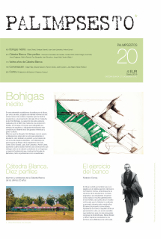Transfers. From the studio to the classroom, from Barcelona to Venice
DOI:
https://doi.org/10.5821/palimpsesto.20.8951Keywords:
Transfers, Re-use, Barcelona, Venice Architecture Biennale.Abstract
In the classroom, as in our study, each project makes appear and develop interests that help it move forward and go beyond the specific solution, beyond the specific circumstances, of the urgency of the assignment. This allows developing long-distance topics, where each project sets a reflection that will have an echo in the next. In the classroom we wanted to transfer these reflections and bring them closer to the students with an exercise where they can share and contrast other possible ways of interpreting and acting.
The re-use of buildings, their adaptation to host new programs is one of the issues that concern and fascinate us at the same time, and we have brought it to the ETSAB classrooms and other schools where we have been teaching during these last years. We thought it was a good time to show it in this gigantic showcase that is the Venice Architecture Biennale, where each participant, in addition to responding to the Biennale commissioners manifesto, has their own reflection topics to share in an international debate field.
Downloads
Published
Issue
Section
License
PROTECTION AND INTELLECTUAL PROPERTY CRITERIA
Authors whose work is published in en Palimpsesto agree to the following terms:
1. The author retains the copyrights and guarantees the magazine the right to apply a Creative Commons Attribution-NonCommercial-NoDerivatives (CC BY-NC-ND), which permits others to share the work with acknowledgement of authorship.
2. The author may establish additional agreements of his or her own accord for non-exclusive distribution of the article published in the magazine (for example, in an institutional repository, or published in a book).
3. Electronic distribution of the work by the author(s) is permitted and encouraged (for example, in institutional repositories or on the author’s own website), prior to, and during the submission process, as this can generate productive exchanges, as well as earlier and greater citation of the published works (see The Effect of Open Access) (in English).
4. The author or provider of the material submitted for publication authorizes Palimpsesto to publish, with no obligation whatsoever (financial or otherwise) to the content of said material, be it in paper or digital format, or in any other medium.
5. The author or provider guarantees that he or she is the owner of the Intellectual Property rights to the contents provided, which encompasses the text and images/photographs/photographic works incorporated in the article.
6. The author or provider, exempts Palimpsesto magazine of all and any responsibility relating to violation of copyrights, thereby committing himself or herself to undertaking all efforts to assist Palimpsesto magazine in defence of any accusation, extra-judiciary, and/or judicial measures. Likewise, the author or provider will assume payment to Palimpsesto of any sum or compensation that must be paid to third parties for failure to comply with these obligations, be it the result of judicial, arbitrary or administrative decisions.
7. The submission of the texts by authors implies automatically a declaration of non plagiarism of its contents







